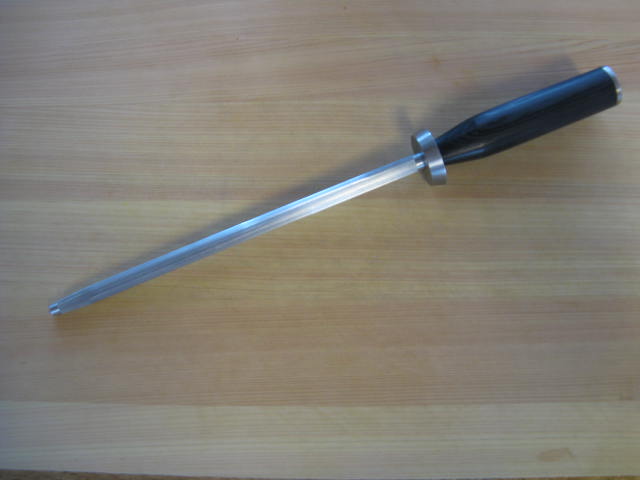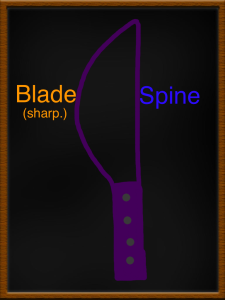Greetings, readers!
As promised, I have assembled a “How To” instructional guide on how to hone a knife in what I think is a very non-scary way. I was taught this method by a pretty respectable Wustof knife representative (and I am very wary of salespeople!).
So enjoy! Click the link below. Let me know if you think I missed anything pertinent!
Check out How to Hone a Knife.
Category Archives: Knives
Sharpening Your Knives
I do not recommend sharpening your own knives, at least not if you paid a lot of money for them. Most places charge $1/inch. I do, however, recommend taking it to an actual knife sharpener or store that uses a stone/wheel. Even if you have really cheap knives, if you keep them sharpened they will treat you well!
Stores like Sur la Table charge you for them to use a Chef’s Choice electric sharpener. If that’s you plan, then I would recommend buying a Chef’s Choice electric sharpener for your home. That is the best brand. 🙂
***If you are using an electric sharpener, do NOT push down on the knife when running it through. Just pass it through.***
- You should probably read the directions…just sayin’!
- Some of them come with an extra step that you don’t use every single time
- Some have a slot for only Asian knives
You can buy some inexpensive sharpeners at most kitchen stores, and most brands will make one with their brand name on it and these will get you by. The biggest mistake folks make with these is that they never hone them and sharpen them too often, so don’t fall into that category! Hone so you don’t have to sharpen!
The most popular and effective inexpensive sharpener is the Wustof hand-held guy. They used to have one for Asian and one for regular, and now they sell a universal one for around $30.
Shun now carries a pretty cool whetstone set that takes the guesswork out of finding the perfect angle. Pretty nifty, and comes with their honing steel!
 |
| Shun Steel – for honing, not sharpening, although a lot of times a steel is called a “sharpening steel” in a retail setting. |
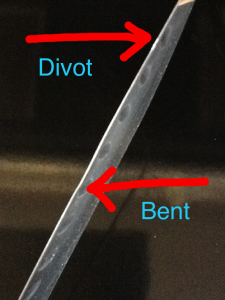 |
| This knife is in dire need of a sharpening! |
You will need to get your knives sharpened one to two times per year, if you hone regularly (Re: Knife Care). I take mine to someone who uses the Kramer Method (series of seven belts) versus a wheel, and this keeps the knives sharp for about one year. If your person is using a wheel/stone (this is normal/standard), you will probably need it done twice a year. This obviously varies by how much you actually use and hone individual knives.
- Honing brushes off miniscule dings and divots you put in the blade with regular use. Brushing these off keeps the knife in shape; if you leave them, you’ll end up starting to have to use more force to get the knife to cut because the blade isn’t straight.
- If you don’t hone your knives, you will need to get them sharpened a LOT more often.
- Bob Kramer is the man who created the seven-belt method. I told you he knows a lot about knives!
Knife Storage
The best way to keep your knives is in a wood block with horizontal slots. Why horizontal? Pulling your knife in and out of a vertical slot actually drags the knife along the slot and dulls it. Crazy, right?! Not everyone likes a block or has space for it, so here’s the best to worst:
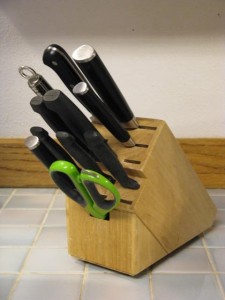 |
| I found this wood block for $1 second-hand! Horizontal slots…perfect! |
1. Wood block (horizontal slots)
- Unless you buy a really fancy one, the steak knife slots are usually going to be vertical; I’d only recommend splurging if you have really fancy steak knives!
2. In-drawer wood 3. In-drawer plastic 4. There’s these crazy new ones out that have thin plastic rods in lieu of slots, so your knife can go anywhere in the block! 5. Magnet 6. Throw them in the drawer loosely and make a game out of grabbing them without looking 😛
If you have to use a magnet, there’s a way to save your knives some injuries (and yourself!). Place the spine on the magnet first, then lay the knife down on its side gently. Remove it in the opposite manner. This will avoid scratching the metal body of the knife and dragging the blade across the magnet and dulling it.
Ceramic Knives
Ceramic knives are pretty cool. I admit I was once a skeptic and often told customers I would be extremely worried about breaking them. They probably do fall into that category with Asian knives—if you aren’t going to care for it properly (re: wash it immediately after use and put it away), don’t buy it.
I have since been able to handle several ceramic knives, mainly Kyocera, and these guys are pretty awesome. They are actually pretty strong—the sales rep let me drop one several times onto the hardwood floor. That was really my only holdout, and the simple act of dropping it made me a believer. Not saying you should throw them on the floor–they are still potentially breakable. Plus you don’t want to cut your foot. 😉
 |
| I don’t own a ceramic knife, but it would be great for cutting all this produce! |
The other amazing thing about ceramic knives, which I’ve always endorsed, is the fact that they stay sharp 10x longer than a steel knife. A great option if you’re not into honing and sharpening. They’re also rust and stain-proof, as well as germ-resistant. People love these for slicing fruits and veggies because ceramic won’t brown foods like steel knives can, or transfer a metallic taste or smell to the food.
The cool thing about Kyocera in particular is that they will actually sharpen your ceramic knives for free, you just have to pay to mail them in. Lifetime offer–not a bad deal!
I recommend buying a 6-8” chef knife for a budding young chef on their way to college. They won’t have to worry about sharpening, and they will have it forever if they take good care of it.
PS — They also make peelers and mandoline slicers, which is great because it’s next to impossible to sharpen the blades on regular metal ones, but a ceramic version will stay sharper way longer.
Knife Care
Wash and dry your knives immediately after use. You honestly only really need to rinse them off and dry them most of the time. Pretty much all knives are food-service certified, and stainless steel is non-porous so germs can’t “get in”.
- Most of the time I just run warm water and very carefully wash with my fingers, then towel-dry, and this is the recommended method by all knife manufacturers.
Dishwashers – I always say if you love it, don’t put it in the dishwasher. But if you’re going to do it, do NOT lay them flat on the racks–use the plastic flatware basket. If it doesn’t fit, wash it by hand.
- Reason: Your dishwasher shakes; this is part of how it cleans. Things bump each other, and your knife will bump the plastic coating on the prongs repeatedly, cutting them and exposing the metal underneath, and then pretty soon your flatware will all start coming out rusty. You will need to buy new racks or a whole new dishwasher, and also new flatware.
Citrus (including soap—don’t use it!) is bad for stainless steel! After cutting citrus, clean immediately.
Always use a cutting board. Your knife needs something to cut through to, and a hard granite countertop will ruin your knives!! (It’s funny because a lot of people with granite countertops are worried about ruining the granite, but it works the other way around!) It should go without saying, but here it is: don’t cut things in your pans. It’s bad for both items, generally.
In order from best to worst cutting board options:
- Wood!
- Wood is naturally anti-microbial, so even though it sounds gross, you don’t really have to wash it. Soap is actually bad for wood and you will have to oil it more often than normal. [More on wood care later!]
- Epicurean brand cutting boards take the care out of owning wood if this is your issue
- You don’t have to oil this brand because the wood is compressed with food-safe resin, making it extremely durable and non-porous. They’re also made in the USA!
- Plastic – not bad, but plastic needs to be replaced regularly to avoid germs
- You might consider having separate boards for meat and veggies
- Acrylic – very hard on your knife
- Glass – bad! Your knife can’t cut through this
- Marble – even worse!
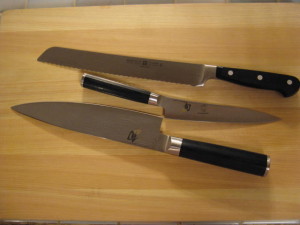 |
| My wood cutting board; I leave this one out on the counter; I have smaller plastic ones I keep in a drawer. |
Buy kitchen scissors! Most people ruin knives by using them like scissors. Get a cheap pair and stop cutting bags open with your knives!
Hone (not sharpen) your knives regularly. If you are using the same knife a lot, it’s probably a good idea to hone it once a week.
- This brushes out any minor dings, which helps keep it in shape longer. The less you hone, the more you need to sharpen, and it’s not good for your knife to be re-edged frequently.
- If you own Asian knives, which are generally a harder steel than German-style knives, be aware that your sharpening steel (what you use to hone the knife) needs to be a harder metal than your knife. As long as you have an Asian steel, you can use that on all of the knives in your collection — just don’t use a German steel on an Asian knife.
- [I may eventually post a video of my non-scary method of knife honing!]
You will need to get your knives sharpened once or twice per year if you hone regularly. I take mine to someone who uses the Kramer Method (a series of seven belts) instead of a wheel; this keeps the knives sharp for about one year. If your person is using a wheel or stone, which is a standard technique, you will probably need it done twice a year.
- Naturally, this varies by how much you actually use individual knives.
- If you don’t hone your knives, you will need to get them sharpened a LOT more often.
- I haven’t read it myself, but I’ve heard from several friends who know a lot more about knives than I do, that the Sur La Table book, “Knives Cooks Love” is a great way to nerd out on knives in even greater depth. Bob Kramer, a Master Bladesmith and also considered a world-renowned knife guru, contributed to this book, and Sur la Table also sell his knives.
- Cutting yourself on a dull blade is way worse than cutting yourself on a sharp blade! A sharp blade will make a clean cut that should heal rather quickly, whereas a dull blade will usually be more jagged and be deep because it generally takes more force to utilize. You are also less likely to scar–it’s really about tissue damage, and you’ll do less with a sharp blade.
